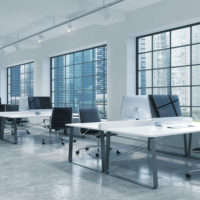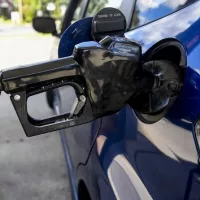
ismagilov/iStockBY: LEIGHTON SCHNEIDER, ABC NEWS
(NEW YORK) — Imagine going to work.
If you work in an office building, you probably have to go through the front doors, maybe past a security desk. You might even get on an elevator.
You may pick up some coffee or tea in the break room and say hi to a coworker, before finally sitting down at your workspace.
Sounds pretty normal so far, but as many states begin the process of reopening, it’s time to start thinking about how to keep those workplaces germ free.
On ABC News’ “Perspective” Podcast, Mark Ein, the CEO of Kastle Systems, a security company specializing in office buildings, said technology can play a role in monitoring surfaces around the building that could have the virus, starting at the front door.
“As you approach the building, the security app on your phone, which we [already] have today, will connect with the motorized door, because the app says that you’re authorized to come into the building, the door will open automatically,” said Ein.
That same smartphone app can also save you from touching elevator buttons.
“Other than pushing both the floor and that you need an elevator. You’ll put it in your app and the app will talk to the elevator, call the elevator and tell it where you’re going,” said Ein.
The app is part of a larger plan that Kastle has come up with called Kastle Safe Spaces. Ein says it’s designed as a framework employers can use as they start to bring workers back.
There’s even a version of an immunity passport scaled down for use around the office.
“At the point when we have widespread testing, if we also use antibody testing as a way to determine who is safe, all of those things can be entered into your health record and you can effectively get an easy pass if you’re known to be safe,” Ein said.
The easy passes can also work in reverse by tracking people who may not have symptoms, but could still be spreading the virus.
It’s a form of contact tracing, which is considered by the CDC to be a key strategy in slowing the spread of coronavirus.
Apple and Google have recently teamed up to develop their own tracing technology, but those strategies all address large populations.
Howard Tiersky, the CEO of FROM, a digital marketing firm, developed an app is designed specifically for the workplace by using the Bluetooth on your smartphone.
“It’s recording what we call an incident, and an incident is a period of time when you get closer than a certain threshold to another person with the app. It’s generally around seven feet and it records how long you were near that person, who the other person was, and approximately how far away from them you were,” Tiersky told the “Perspective” podcast.
There can downsides to contact tracing in an office, according to Quentin Rhoads-Herrera, the professional services director at cybersecurity firm Critical Start.
He tell’s “Perspective” it could make it easier for employees to identify sick coworkers, even if the data is anonymized.
“All of a sudden one person disappears, and now I’m getting an alert that I’ve been around somebody who has been infected with COVID-19. Well, I’m going to be able to make an assumption that was that person,” said Rhoads-Herrera.
That could have unintended consequences.
“Nobody wants to be shamed for something like COVID-19, or anything and I think that would lead to that,” said Rhodes Herrera.
For his part, he says that it’s an employer’s responsibility to create a corporate culture where that type of shaming is not allowed. Similar to anti-discrimination policies around gender, age, or disability reporting.
Copyright © 2020, ABC Audio. All rights reserved.















